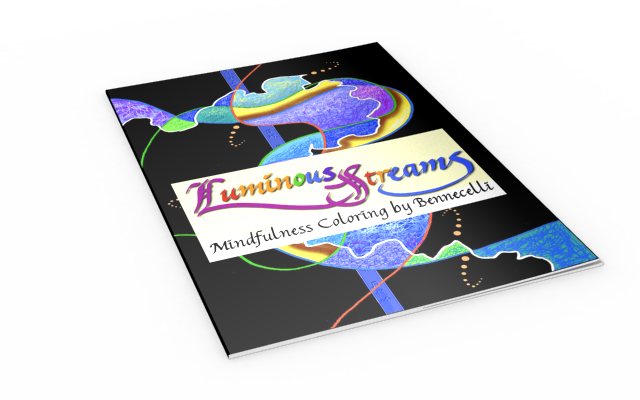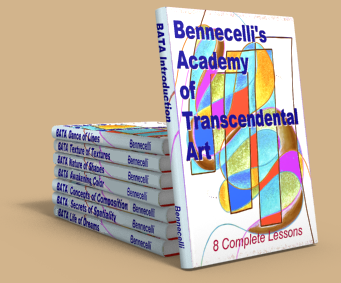|
About Bennecelli's Art
After graduating from art school
in 1972, Bennecelli distanced himself from the
world of fine arts for over forty years. He made
this decision for two distinct reasons. Firstly,
his creative focus shifted towards teaching, and
secondly, he believed that fine art had lost its
sense of direction.
Upon reentering the art world, Bennecelli soon
realized that his reasons for stepping away had
been justified. The art world was still trapped in
the same directionless condition as it had been in
1972.
Bennecelli's departure from the art world and
subsequent return were driven by a combination of
personal and artistic reasons. His dedication to
teaching and his belief in the decline of the fine
arts as a cultural force led him to step away for
several decades. However, his reentry into the art
world was sparked by vivid dreams that provided
him with a renewed sense of purpose and
inspiration. These dreams guided him towards the
study of sacred texts and presented him with a
captivating vision, which he transformed into a
prolific series of paintings known as "Luminous
Streams.#
Bennecelli views his paintings two ways -- first,
as beautiful, engaging decorative designs and
second, in more depth, as images that portray
elements of a reality and forces of nature beyond
the realm of the five senses. This is a
transcendental vision from his subconscious -- a
way forward for a troubled and uncertain world
full of doubts and skepticism and teetering on the
edge of destruction of ourselves and the planet.
The major theme of Bennecelli's art is the
timeless beauty of the rhythmic energy of life
uniting art, music, and dance through expressive
lines, textures, and radiant colors. This is
portrayed in a calligraphic form which engages our
minds in positive ways.
Perhaps surprisingly, he does not consider his
paintings to be abstract art, but rather, he sees
them as embodying a new vision of reality,
revealing the energy and forces at work throughout
all existence. Indeed, his art is all about a
vision from the subconscious that offers a way
forward from our very troubled and even reckless
times.
He believes it is important that we balance the
scientific objectivity and the arts with a new
metaphysical vision, and this is exactly what his
art does.
The “Luminous Streams” paintings are created
intuitively and spontaneously with minimal
preliminary sketches or plans. In this way, they
bring to consciousness, images (just as the vision
in his dream) of reality perceived by the
subconscious mind. The subconscious mind is the
source of a keen perception of the infinite beyond
the limits of the rational, temporal mind.
His art has become his teacher and mystical guide
-- presenting a way for him to attain insight and
to grow in his awareness of our beautiful, shared
reality beyond the realm of the five senses and to
achieve a clear vision of a positive future.
Each painting is composed of just four lines (red,
blue, green, and white). These colors are symbolic
of emotions, intellect and spirit, physical being,
and the self. Four is a significant number, e.g.,
four fundamental forces of the universe, four
points on a compass, four seasons of the year,
four classical elements, etc.
Each of the four lines enters and exits the canvas
at the edges. This implies that the configuration
of lines within the limits of the canvas is part
of a much larger, even infinite, network.
These paintings are amazingly luminous, something
which unfortunately cannot be photographed
accurately. Their luminosity was created using a
five-hundred-year-old technique of applying layers
of transparent paint over a brightly colored
ground to achieve what has been called the
"Venetian Glow.” The technique was developed by
the Renaissance painters of Venice, Italy.
Bennecelli's color palette is based on a color
system of four complementary pairs. He does not
use the traditional red-yellow-blue primary
system. In fact, he developed his own system after
studying color properties extensively as they
relate to the spectrum, our vision, and color
mixing. He has studied all the major color systems
including Ostwald, Munsell, and Birren.
In addition to the shapes created by the four
lines, there are two additional elements in his
paintings.
First, there are small dots extending from the
forms into the black void of the background. These
imply rotation and help us see that the forms
exist within the background and are not simply
cut-outs sitting on top of the background.
Second, there are vertical or horizontal strips in
many of the paintings which appear to contain
archaic writing. These strips are darkly subdued
in color and at first are not usually noticed.
They offer a contrast between the organic forms
and the geometric, the emotions and the intellect.
They also imply that there is an important message
contained within the paintings which is both
ancient and mysterious. The strips add a sense of
the mystical to the whole composition.
These paintings are truly different from
Bennecelli's previous work over fifty years which
includes calligraphy, realistic portraits in oils
and pastels, pen and ink illustrations, monotypes,
and geometric shaped canvases. He views his
artwork for the past four years as the realization
of his lifelong quest to create art that is truly
authentic and meaningful. Thankfully it has also
been enthusiastically received by the public.
|




 "Angelic
Presence# excellent for relieving stress.
"Angelic
Presence# excellent for relieving stress. "Running with the Wind#
for achieving success.
"Running with the Wind#
for achieving success. "Syncopation Formation#
for experiencing joy.
"Syncopation Formation#
for experiencing joy. "Heartbeat#
for
excellent health & longevity.
"Heartbeat#
for
excellent health & longevity.






